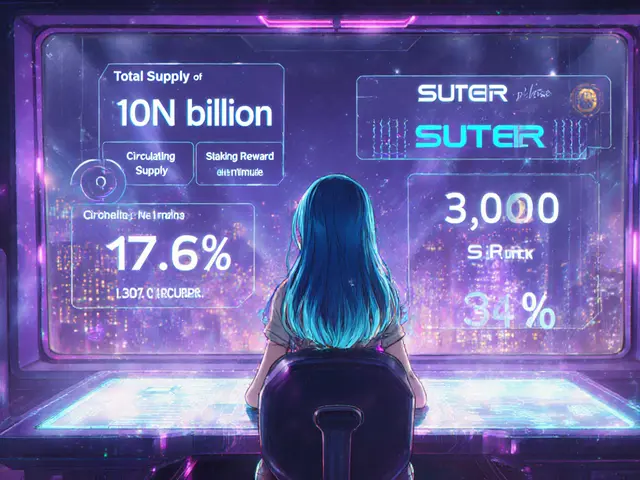SushiSwap Celo Fee Calculator
Fee & Reward Calculator
Estimate trading fees and potential rewards on SushiSwap (Celo).
Estimated Results
Total Trading Fee: $0.00
Protocol Fee (0.05%): $0.00
Liquidity Pool Bonus (0.20%): $0.00
Potential SUSHI Reward: 0 SUSHI
Annualized Return (APR): 0%
Gas Cost: ~$0.00
Quick Summary
- SushiSwap (Celo) brings the popular AMM model to the low‑fee Celo blockchain.
- Trading fees start at 0.25% and liquidity providers earn SUSHI rewards plus bonus incentives.
- Connect any Celo‑compatible wallet (e.g., Valora, Metamask) in seconds and start swapping.
- Key tools - BentoBox, Kashi, and SushiBar - let you earn yield beyond simple swaps.
- Pros: low gas, community governance, strong rewards; Cons: fewer token listings than big centralized exchanges, no formal support.
SushiSwap (Celo) is a decentralized exchange (DEX) that runs as an automated market maker (AMM) on the Celo blockchain. It mirrors the original SushiSwap launched on Ethereum in 2020 but adapts the smart‑contract suite to Celo’s proof‑of‑stake environment, giving users fast, cheap transactions while keeping full custody of their assets.
How the AMM Model Works on Celo
Like any AMM, SushiSwap replaces order books with liquidity pools. Each pool pairs two tokens - for example, CELO/USDC - and uses a constant‑product formula (x*y=k) to price swaps. When you trade, you add one token to the pool and pull out the other, with the price automatically adjusting based on pool depth.
On Celo, gas fees are typically under $0.01, making even small swaps economical. The protocol also integrates Celo’s native “cUSD” stablecoin, which acts as a low‑volatility bridge for traders who want to avoid price swings.
Core Components and Tokens
Understanding the main building blocks helps you decide where to earn the most.
- SUSHI - the governance token that also serves as a reward for liquidity providers (LPs). Holders can stake SUSHI in the SushiBar to receive xSUSHI, a token that automatically earns a share of protocol fees.
- BentoBox - a vault architecture that maximizes capital efficiency. All assets deposited into SushiSwap first sit in BentoBox, allowing multiple DeFi apps (like Kashi) to share the same collateral.
- Kashi - a lending platform built on top of BentoBox. It lets you create isolated lending pairs (e.g., CELO‑borrowers against cUSD collateral) without affecting other markets.
- SushiBar - the staking hub where you lock SUSHI for xSUSHI and earn a slice of the 0.05% protocol fee collected on every trade.
- BentoBox also powers “Kashi” and “Trident” - the next‑gen AMM that offers multiple fee tiers and custom curve options.
Fees, Rewards, and Incentives
Every swap on SushiSwap (Celo) incurs a 0.25% fee. Of that:
- 0.05% goes straight to xSUSHI holders via the SushiBar.
- 0.20% stays in the pool, boosting LP returns.
Liquidity providers also earn extra SUSHI rewards through “incentive farms.” The SUSHI/CELO pool currently offers a 2× SUSHI emission rate compared with standard farms, meaning your LP tokens generate twice the token reward per block.
Because Celo’s gas is negligible, the net APR for high‑depth pools often exceeds 30% annually, especially when you combine pool fees with SUSHI emissions.

Getting Started on SushiSwap (Celo)
- Choose a Celo‑compatible wallet. Valora, Metamask (configured for Celo), or the native Celo Wallet work out of the box.
- Connect to the DEX. Visit app.sushi.com, click “Connect Wallet,” and pick the Celo network.
- Swap tokens. Select the pair (e.g., CELO → cUSD), enter the amount, and confirm the transaction. The UI shows estimated gas (<$0.01) and slippage.
- Provide liquidity. Navigate to “Pool,” choose “Add Liquidity,” and deposit both assets in the required ratio. Your LP tokens appear in the “My Liquidity” tab.
- Stake LP tokens for extra rewards. Click “Farm,” select the pool, and press “Stake.” You’ll start earning SUSHI on top of the pool fees.
- Optional: Stake SUSHI in SushiBar. Go to the “Bar” page, lock your SUSHI, and receive xSUSHI, which accrues a share of protocol fees automatically.
All steps are designed for a “no‑code” experience, but a basic understanding of transaction confirmations and gas limits is helpful.
Pros vs. Cons - Comparison with Other Celo DEXs
| Feature | SushiSwap (Celo) | Ubeswap | CeloSwap |
|---|---|---|---|
| Trading fee | 0.25% (0.05% to xSUSHI) | 0.30% | 0.20% (no fee redistribution) |
| Liquidity incentives | Double SUSHI rewards on select pools | Single‑token farming | None |
| Cross‑chain support | Multi‑chain via Trident, Binance Smart Chain, Polygon | Limited to Celo | Only Celo |
| Governance | SUSHI token holders vote on proposals | Community DAO (CELO‑based) | No formal governance |
| User interface | Restaurant‑themed, beginner‑friendly | Standard DEX UI | Minimalist, fewer tutorials |
| Security audits | Multiple audits (Etherscan, Certik) and bug bounty | One audit (2023) | No public audit |
The table shows why many traders pick SushiSwap for its fee‑back mechanism and cross‑chain flexibility, even though the token list on Celo is narrower than on Ethereum.
Security, Risks, and Regulatory Landscape
Because SushiSwap is non‑custodial, you never hand over private keys. That eliminates “exchange hack” risk, but you still face smart‑contract bugs, impermanent loss, and market volatility.
- Smart‑contract risk. The core AMM contracts have been audited, yet exploits can arise from new features (e.g., Trident). Use only well‑reviewed pools.
- Impermanent loss. Providing CELO/USDC liquidity can cause temporary loss if CELO’s price swings sharply. Calculators embedded in the “Pool” page help you estimate it.
- Regulatory uncertainty. DeFi platforms are largely unregulated worldwide. Celo’s stablecoin ecosystem is gaining compliance attention, but no KYC is required on SushiSwap.
Best practice: keep only the amount you’re willing to lose in LP positions, and store the bulk of your assets in a hardware wallet.
Future Roadmap for SushiSwap on Celo
Community polls slated for Q42025 aim to:
- Introduce “Trident” fee tiers (0.03%‑0.10%) on Celo to attract high‑frequency traders.
- Launch a native Celo yield‑aggregator that auto‑re‑balances between BentoBox farms.
- Integrate Celo’s upcoming “cEUR” stablecoin, widening the stable‑pair market.
- Expand the Sushi Academy with video tutorials tailored for Celo newcomers.
These upgrades should improve capital efficiency and keep the platform competitive against newer DEXs entering the Celo ecosystem.
Quick‑Start Checklist
- Install a Celo‑compatible wallet (Valora or Metamask with Celo network).
- Purchase CELO or a stablecoin (cUSD) on a bridge or exchange.
- Connect wallet to SushiSwap and select the Celo network.
- Swap tokens or add liquidity to a pool.
- Stake LP tokens in a farm for extra SUSHI rewards.
- Optional: Lock SUSHI in SushiBar to earn protocol fee share.
- Monitor gas fees (<$0.01) and slippage settings before each transaction.

Frequently Asked Questions
Do I need to pay gas on Celo when using SushiSwap?
Yes, but Celo’s gas is extremely cheap-typically under $0.01 per transaction-so even frequent swaps stay affordable.
Can I trade tokens that aren’t listed on SushiSwap (Celo)?
Only tokens with deployed Celo‑compatible contracts appear in the pool list. You can bridge new ERC‑20 assets to Celo via the Opti‑Bridge, then add them as a custom pool if you provide the initial liquidity.
What’s the difference between SUSHI and xSUSHI?
SUSHI is the native governance token you can trade or stake. When you lock SUSHI in the SushiBar, you receive xSUSHI, which represents a claim on a portion of the protocol’s 0.05% fee collected from every trade. xSUSHI’s value grows over time as fees accrue.
Is SushiSwap (Celo) safe for beginners?
For basic swaps and single‑token staking, the UI is straightforward and the low gas makes experimentation cheap. Beginners should start with small amounts, use the built‑in tutorials, and avoid complex yield‑farm combos until they’re comfortable with impermanent loss.
How does governance work on SushiSwap?
SUSHI holders can submit proposals on the SushiSwap DAO forum and vote using their token weight. Proposals range from fee‑tier adjustments to new pool launches. Votes are executed automatically once a quorum is reached.












Katrinka Scribner
June 14, 2025 AT 23:26 PMSushiSwap on Celo looks sooo promising! 😊 I’m already picturing my wallet fillin up with SUSHI 🍣. The low fee calculator is a game‑changer, even if the UI looks a lil weird now.
Jacob Anderson
June 15, 2025 AT 16:10 PMOh great, another DEX trying to be the savior of low‑fee trading. As if we needed more options to lose money on Celo.
Oreoluwa Towoju
June 16, 2025 AT 08:00 AMFor newbies, keep an eye on gas costs; they can eat into tiny profits fast.
Amie Wilensky
June 16, 2025 AT 23:16 PMIndeed-while the fee calculator provides a baseline, one must also consider slippage, liquidity depth, and potential impermanent loss; otherwise projections become meaningless.
Charles Banks Jr.
June 17, 2025 AT 14:33 PMSure, the calculator shows zero fees right now, but that’s because you haven’t actually put anything in the pool. Once you start swapping, the protocol fee of 0.05% will show up, and the liquidity bonus will fluctuate based on pool health. Plus, the APR numbers are just a snapshot; they can swing wildly depending on market conditions. Bottom line: don’t take the zeroes at face value.
Ben Dwyer
June 18, 2025 AT 05:50 AMLook, the tool is handy for a quick estimate, but always double‑check the actual transaction on chain. That’s the safest way to avoid surprises.
Lindsay Miller
June 18, 2025 AT 21:06 PMThe calculator is simple enough for anyone to use, and it helps beginners see how small fees add up. Just remember real trades involve more than numbers on a screen.
Waynne Kilian
June 19, 2025 AT 12:23 PMEven if the UI looks a bit rough, the underlying math is solid. It’s good to see a tool that tries to demystify DEX fees for the community.
Michael Wilkinson
June 20, 2025 AT 03:40 AMDon’t forget to factor in the hidden gas spikes during peak times; they can eat a big chunk of any tiny arbitrage you’re hoping for.
Clint Barnett
June 20, 2025 AT 18:56 PMWhen you first glance at the SushiSwap Celo fee calculator, the numbers can feel almost too good to be true, especially the zero‑fee display for a fresh trade.
However, digging deeper reveals that the “zero” is a placeholder pending actual transaction data, and real‑world swaps will inevitably incur the protocol fee of 0.05% and the liquidity pool bonus of 0.20% which together shape your effective cost.
The calculator’s strength lies in its ability to let users simulate different trade sizes, giving a sandbox‑like environment to understand how slippage scales with volume.
Moreover, the reward projection for SUSHI tokens is an essential feature for yield farmers, but it’s based on current APR assumptions that can shift dramatically with market dynamics.
One must also consider the underlying network conditions on Celo; while gas costs are generally lower than on Ethereum, congestion spikes can still raise transaction fees enough to erode thin margins.
Another layer of complexity is the liquidity depth of each pair-CELO/USDC, CELO/cUSD, SUSHI/CELO, ETH/USDC-each behaves differently under pressure, affecting both price impact and reward accrual.
Experienced traders often cross‑reference the calculator’s output with on‑chain analytics tools to verify that the projected returns align with live pool data.
This cross‑checking habit helps avoid the trap of over‑optimistic expectations set by a static calculator view.
In addition, the platform’s governance token, SUSHI, carries its own price volatility, meaning that the nominal reward amount may not translate directly into stable value.
For risk‑averse participants, it’s wise to convert projected SUSHI earnings into a stablecoin benchmark before committing significant capital.
While the calculator does a decent job at presenting fee and reward estimates, it does not factor in the potential impermanent loss that can arise when providing liquidity versus merely swapping.
That loss can be mitigated by selecting pairs with correlated assets, but it’s still a crucial consideration for long‑term LP strategies.
Overall, the tool serves as a practical entry point for newcomers to gauge the cost structure of SushiSwap on Celo, but it should be used in conjunction with deeper research and real‑time data feeds.
In short, treat the zeroes as a starting hypothesis, not a guaranteed outcome, and always factor in the dynamic nature of blockchain markets.
Kate Nicholls
June 21, 2025 AT 13:00 PMWhile Jacob’s sarcasm is entertaining, the reality is that each DEX adds competitive pressure that can drive fees down overall. It’s not just about more choices; it’s about better pricing for users.
Carl Robertson
June 22, 2025 AT 07:03 AMAmie’s point about slippage is spot‑on, but let’s not forget the drama of sudden liquidity withdrawals that can turn a smooth swap into a nightmare. The market’s mood can shift in minutes.
Rajini N
June 23, 2025 AT 01:06 AMBen, you’re right about double‑checking on chain. Adding a quick view of the transaction receipt can save you from hidden surprises, especially when the calculator shows zero fees.
Kate Roberge
June 23, 2025 AT 19:10 PMKatrinka’s excitement is contagious, but let’s stay grounded – the UI may look shiny, yet the underlying smart contracts still need thorough audits before we hand over big sums.
Jason Brittin
June 24, 2025 AT 13:13 PMCharles, you nailed the nuance of the zero‑fee snapshot. It’s a reminder that DEX stats are fluid, and a little sarcasm helps keep the conversation lively 😊.
MD Razu
June 25, 2025 AT 07:16 AMOreoluwa’s tip about gas costs is crucial, but to truly grasp its impact you need to simulate multiple trades across different network load scenarios; otherwise you’ll underestimate the cumulative expense.
VICKIE MALBRUE
June 26, 2025 AT 01:20 AMCelo is heating up!
Naomi Snelling
June 26, 2025 AT 19:23 PMDon’t forget the hidden layer that could be tracking every swap you make.